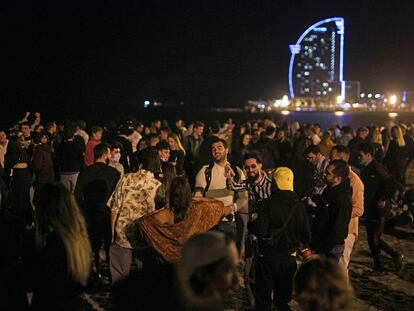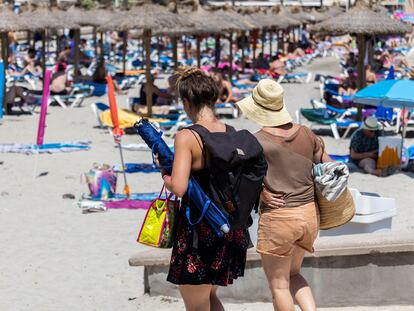Spain’s regions reintroduce coronavirus restrictions as fifth wave gains pace
With the incidence rate rising to 368 per 100,000 inhabitants, the Valencia region has approved a curfew in 32 municipalities, while Catalonia is seeking to limit public and private social gatherings

Covid-19 is not letting up in Spain and the epidemiological curve is continuing to spike in what is a fifth wave of the virus, this time with explosive growth. The 14-day cumulative number of coronavirus cases per 100,000 inhabitants has shot up 80% in the last week, and according to Monday’s Health Ministry report – which did not include data from the Balearic Islands or Catalonia, which failed to supply any information – is now at 368.
The ministry also reported 33,932 new infections and added 17 official Covid-19 victims to the overall death toll on Monday. In total, there have been 3,971,124 coronavirus infections detected since the pandemic hit Spain, and 81,020 have died after testing positive for Covid-19.
The vaccination campaign has become the key factor for keeping the advance of the pandemic in check, with nearly 46% of the Spanish population now having full coverage from one of the vaccines being used. But infections are rampant among the under-30s, which is the section of the population that is yet to have had mass access to inoculations. As such, the cumulative incidence among the 20-29 group is now at nearly 800 cases per 100,000 inhabitants.
With this scenario on the table, the country’s regions – which are in charge of coronavirus measures and their vaccination campaigns – are opting to reintroduce the toughest restrictions seen so far during the health crisis.
The Valencia region, for example, has already secured the approval of the justice system to impose a curfew in 32 municipalities and limit social meetings throughout its territory. The Canary Islands, meanwhile, have requested restrictions on nightlife and Catalonia, which last week closed its nighttime venues, has approved the closure of non-essential activities at 12.30am and limiting social meetings to a maximum of 10 people.

Fernando Simón, the director of the Health Ministry’s Coordination Center for Health Alerts (CCAES), admitted on Monday that the expectation is for infections to continue to rise over the coming days. “In two days we will be above 400 [cases per 100,000 inhabitants over 14 days],” the epidemiologist explained. The peak of the epidemiological curve, he continued, is likely to be close, but he did not venture to suggest a date. He did add that the speed of the increase is starting to slow.
On the streets of Spain, however, and at primary healthcare centers, there is no sign of that slowdown. The pandemic is continuing to spread apace, and is threatening to overcome the primary healthcare system. In fact, Catalonia – which has one of the highest infection rates in Spain, with more than 2,000 cases per 100,000 inhabitants among the 20-29 group – has already announced that its services will no longer be carrying out diagnostic tests on asymptomatic close contacts of people with coronavirus infections given the flood of cases and the pressure they are causing on healthcare centers.
If we continue to have very high incidences among those who have not been vaccinated, there could be an impact on hospitalsFernando Simón, director of the Health Ministry’s Coordination Center for Health Alerts
“The pressure now is being borne by the primary care services and public health,” Simón warned. “If we continue to have very high incidences among those who have not been vaccinated, there could be an impact on hospitals and there could be regions that have excessive pressure.”
Given that most of the infections are among young people and the vast majority of the vulnerable population in Spain is already fully vaccinated, and as such protected, the progress of this new wave of the virus is different from that seen in previous waves.
The majority of youngsters experience the illness with either mild symptoms or are asymptomatic, and do not require hospital care. As such, it is likely that for now, hospital occupation will be much lower than at other times during the pandemic.
Simón, however, warned that there is no such thing as zero risk: one in every 100 people under 30 will end up in hospital. “When we end up having a rise in the total number of cases, in the end, hospitalizations in raw terms will be a high number and this will be noted on the levels of hospital occupation,” he warned.
Currently, there are 3,892 Covid-19 patients in Spanish hospitals. This number has grown 43% in the last week. The number of people in intensive care units (ICUs) currently stands at 719, a rise of 17% in seven days.
The regions that are seeking to reimpose restrictions do not currently have the legal framework that was previously offered to them by the state of alarm, an emergency mechanism that the central government implemented in order to allow the regional authorities to restrict fundamental rights of citizens such as mobility without facing challenges in the courts.
So far, Valencia has managed to secure the blessing of the courts for a 1am to 6am curfew in 32 municipalities with more than 5,000 inhabitants and to limit social meetings to 10 across its territory. The Valencia regional court approved the restrictions on the basis they were “balanced” and “proportional.”

The court made reference to the explosion of cases in Valencia, the risk that the primary healthcare system could be overwhelmed, and the risk of the more infections delta variant, which is up to 60% more transmissible according to the European Center for Disease Prevention and Control (ECDC).
The Canary Islands, meanwhile, have also requested that the courts grant permission for a new curfew on the islands that are at level 3 of their alert system. For now, this would just affect Tenerife, according to news agency EFE.
Catalonia is going even further than its closure last week of nightlife venues (unless they are outdoors), and on Monday announced a limit of 10 people for public and private meetings and the closure of all non-essential activity at 12.30am – the last step before requesting a nighttime curfew. The limit on meetings infringes on fundamental rights, so the Catalan government will have to get approval from the courts before it can introduce this measure.
The northern region of Navarre also got permission from the courts last week to bring forward the closure of its nightlife venues to 1am. The judges ruled it was a “suitable, necessary and proportionate measure” to contain the spread of the virus among the unvaccinated, i.e. young people, given the direct relationship between the very high number of infections among this group and the rise in nighttime activity now that the school year has finished.
As was seen last year, however, before the state of alarm was implemented, there are once again differences in criteria being seen among the different courts in the country. In Aragón, for example, the courts have rejected measures that closed bars and restaurants at 11pm and nightlife venues at 12.30am. The Aragón regional government has already filed an appeal against the ruling.
The courts have also rejected the decision by the Andalusian authorities to lock down the municipality of Peal de Becerro in Jaén, on the basis that the order from the Health Department did not meet the principles of necessity or proportionality, among others, needed for approval.
English version by Simon Hunter.
Tu suscripción se está usando en otro dispositivo
¿Quieres añadir otro usuario a tu suscripción?
Si continúas leyendo en este dispositivo, no se podrá leer en el otro.
FlechaTu suscripción se está usando en otro dispositivo y solo puedes acceder a EL PAÍS desde un dispositivo a la vez.
Si quieres compartir tu cuenta, cambia tu suscripción a la modalidad Premium, así podrás añadir otro usuario. Cada uno accederá con su propia cuenta de email, lo que os permitirá personalizar vuestra experiencia en EL PAÍS.
¿Tienes una suscripción de empresa? Accede aquí para contratar más cuentas.
En el caso de no saber quién está usando tu cuenta, te recomendamos cambiar tu contraseña aquí.
Si decides continuar compartiendo tu cuenta, este mensaje se mostrará en tu dispositivo y en el de la otra persona que está usando tu cuenta de forma indefinida, afectando a tu experiencia de lectura. Puedes consultar aquí los términos y condiciones de la suscripción digital.
More information
Últimas noticias
There is as much life left to discover on planet Earth as that which is already known
Dozens presumed dead, around 100 injured in fire at Swiss Alps bar during New Year’s celebration
Is porn for women different from conventional porn? We spoke to those who make it
Cartagena de Indias is sinking: What can the city do to mitigate it?
Most viewed
- David King, chemist: ‘There are scientists studying how to cool the planet; nobody should stop these experiments from happening’
- Reinhard Genzel, Nobel laureate in physics: ‘One-minute videos will never give you the truth’
- Oona Chaplin: ‘I told James Cameron that I was living in a treehouse and starting a permaculture project with a friend’
- Sinaloa Cartel war is taking its toll on Los Chapitos
- The Interoceanic Train, the Mexican alternative to the Panama Canal










































